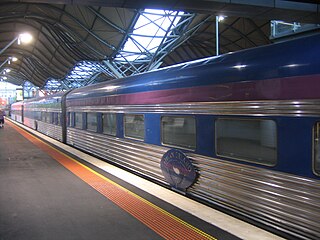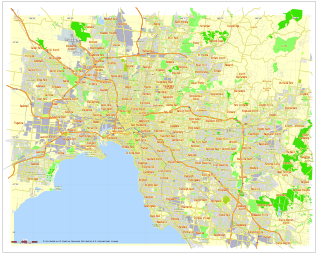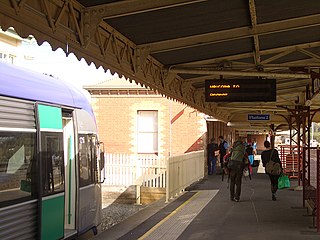
Rail transport in Australia is a crucial aspect of the Australian transport network. Rail in Australia is to a large extent state-based. As at 2018, the Australian rail network consisted of a total of 33,168 kilometres (20,610 mi) of track on three major track gauges.

Rail transport in Victoria, Australia, is provided by a number of railway operators who operate over the government-owned railway lines. The network consists of Victorian broad gauge lines, and an increasing number of standard gauge freight and interstate lines; the latter brought into existence as a result of gauge conversion of the former. Historically, a few experimental 762 mm gauge lines were built, along with various private logging, mining and industrial railways.
Australians generally assumed in the 1850s that railways would be built by the private sector. Private companies built railways in the then colonies of Victoria, opened in 1854, and New South Wales, where the company was taken over by the government before completion in 1855, due to bankruptcy. South Australia's railways were government owned from the beginning, including a horse-drawn line opened in 1854 and a steam-powered line opened in 1856. In Victoria, the private railways were soon found not to be financially viable, and existing rail networks and their expansion was taken over by the colony. Government ownership also enabled railways to be built to promote development, even if not apparently viable in strictly financial terms. The railway systems spread from the colonial capitals, except in cases where geography dictated a choice of an alternate port.

The Overland is an Australian passenger train service between Melbourne and Adelaide. It first ran in 1887 as the Adelaide Express, but has been called the Melbourne Express by South Australians. It was given its current name in 1926. Now operated by private company Great Southern Rail, the train completes two return trips a week covering 828 kilometres between the state capitals. Originally an overnight train, it now operates during the day.

The first railway in colonial South Australia was a horse-drawn tramway from the port of Goolwa on the Murray River to an ocean harbour at Port Elliot in 1854. Today the state has 1,600 mm broad gauge suburban railways in Adelaide, a number of country freight lines, as well as key 1,435 mm standard gauge links to other states.

The Australian Rail Track Corporation (ARTC) is a Government of Australia owned statutory corporation, established in July 1998, that manages most of Australia's interstate rail network.

Rail gauges in Australia display significant variations, which has presented an extremely difficult problem for rail transport on the Australian continent for over 150 years. As of 2014, there is 11,801 kilometres (7,333 mi) of narrow-gauge railways, 17,381 kilometres (10,800 mi) of standard gauge railways and 3,221 kilometres (2,001 mi) of broad gauge railways.
The Serviceton railway line is a railway serving the west of Victoria, Australia that links the state capital of Melbourne to the cities of Ballarat and Ararat, and once extended to the South Australian border as part of the Melbourne–Adelaide railway. In this role it has been replaced by the Western standard gauge line.
The North East railway line is a railway line in Victoria, Australia. The line runs from Albury railway station in the border settlement of Albury–Wodonga to Southern Cross railway station on the western edge of the Melbourne central business district, serving the cities of Wangaratta and Seymour, and smaller towns in northeastern Victoria. The line, owned by VicTrack but leased to and maintained by the Australian Rail Track Corporation, forms part of the Sydney–Melbourne rail corridor.
The Mildura railway line is a heavy rail line in northwestern Victoria, Australia. The line runs from Yelta station to Ballarat station via the settlements of Mildura, Ouyen and Maryborough in an approximate south-southeasterly direction. Initial sections of the line opened from Ballarat in 1874 and the line reached Mildura in 1903.
Nhill railway station is located on the Western standard gauge line in Victoria, Australia. It serves the town of Nhill. Large grain silos are located in the goods yard.

VicTrack, the trading name of Victorian Rail Track Corporation, is a Victorian Government state-owned enterprise which owns all railway and tram lines, associated rail lands and other related rail-related infrastructure in the state of Victoria, Australia, with the exception of the heritage Puffing Billy Railway that is owned by the Emerald Tourist Railway Board.

The city of Melbourne, Australia, has an extensive network of railway lines and yards to serve freight traffic. The lines are of two gauges—5 ft 3 in broad gauge and 4 ft 8 1⁄2 in standard gauge—and are unelectrified. In the inner western suburbs of the city, freight trains have their own lines to operate upon, but in other areas trains are required to share the tracks with Metro Trains Melbourne and V/Line passenger services.
The Western standard gauge railway line is a standard-gauge railway line in western Victoria, Australia. Opened in 1995, it forms part of the Melbourne–Adelaide rail corridor and serves as the principal interstate rail link between Victoria and the western states. The line replaced a number of former broad gauge routes which were gauge converted, and today sees both intrastate and interstate freight traffic, as well as the twice weekly The Overland passenger service. Major towns on the route include Geelong, Ararat, Horsham and Dimboola.

The G Class are a class of diesel locomotive built by Clyde Engineering, Rosewater and Somerton for V/Line between 1984 and 1989.
The Sydney–Melbourne rail corridor is an approximately 960-kilometre (600 mi) standard gauge railway corridor that runs between Melbourne and Sydney, the two largest cities in Australia. Freight and passenger services operate along the route, such as the NSW TrainLink XPT passenger service. The XPT offers a day and night service in each direction.
The Portland railway line is a railway line in south-western Victoria, Australia. It runs from the main Western standard gauge line at Maroona through Hamilton to the port town of Portland.

The Maryborough–Avoca–Ararat railway is a railway line in western Victoria, Australia. It is one of the few railway lines in the state to have been closed and then reopened. Today it is a standard gauge branch line connecting the Western SG with Bung Bong (ballast) and Dunolly (grain), running through Maryborough station.




















